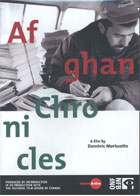
Afghan Chronicles 2007
Distributed by National Film Board of Canada, 1123 Broadway, Suite 307, New York, NY 10010; 800-542-2164
Produced by InformAction and the National Film Board of Canada
Directed by Dominic Morissette
DVD, color, 53 min.
Sr. High - Adult
Asian Studies, Anthropology, Media Studies, Middle Eastern Studies, Sociology, Women's Studies
Date Entered: 02/07/2008
Reviewed by Dan DiLandro, E.H. Butler Library, State University of New York College at BuffaloAfghan Chronicles examines the growth and impact of Killid Media, a Kabul-based press group that embodies two weekly magazines and a radio station in current war-torn Afghanistan. Told in a documentary format with minimal yet helpful narration, the film is truly powerful in its exploration of both the varied aspects of the media group as well as its setting in the panoply of Afghan thought and perspectives.
The director, Dominic Morissette, taught video production and photography in Afghanistan in the early years after the start of the war against the Taliban after September 11, 2001. His artistic skill is evident in the ever-engaging direction and cinematography, but viewers cannot doubt that his visual savvy contributed a knowledge of media to elicit the most from members of the Killid group. Divided into a general-interest magazine, a women’s-oriented magazine, and a radio station, Killid Media is shown through the director’s lens to initiate, embody, and react to Afghan society’s cultural ethos. That is, in attempting to reenergize Afghan mass learning along popular lines, the media group faces both cultural approbation and opposition, but the outlets themselves are also shown to reform articles and features based on readership desires.
In following the journalists, distributors, and vendors, Afghan Chronicles explores not only their day-to-day economic struggles, but makes a specific point to enjoin them in the “new” Afghanistan’s social issues. No scene is a simple “throw away,” but all are woven together in a manner that is both entertaining and extremely educational. The picture provided of Afghanistan today is a complex, subtle one: For instance, the magazine distributors avoid the “bad” areas, where the traffic checkpoints are manned by “conservatives.” This is followed most naturally by subsequent discussions regarding the distain and hatred of “foreign” pictures in the publications – “foreign” meaning barely racy Hollywood and Bollywood stars. And this thread is followed by a vendor who decries such images as bad for society, bad for children. He describes a meeting with a laughing young woman and how he reminded her that it is not democracy to laugh in public and wear jeans, but “it’s heresy.”
Similar threads run throughout the film, and while all involve the Killid outlets, the topics are much, much larger. For instance, scenes of a magazine seller evolve into the narrative of another vendor and, later, a photographer, neither of whom can earn nearly enough money on which to live. One vendor, though, makes more than he would as a trained nurse, though at least half his pay apparently pays for a $30 bag of flour. Ironically, they show us, the high pay of the international aid workers and soldiers increases inflation beyond all scope. The money for the nation’s reconstruction, say the citizens, all goes to the military or is “clearly diverted.”
Perhaps the most compelling episodes in Afghan Chronicles involve the ,em>Mursal women’s-interest journal’s trials. With a mission of providing health, family, and childbirth information to Afghan women, especially in remote areas, the magazine’s staff necessarily faces a number of obstacles from the citizenry and society. It is shocking to hear how the journalists fear suicide bombers, kidnapping, and murder because of an insensitive published joke or that their readers might be punished for learning about basic health care issues. Always complete and balanced, though, Afghan Chronicles is careful to document how the journal can be read to illiterate women by their children and husbands, proving that it is not one group or another that is bad or wrong. Indeed, the film takes a most critical stance toward the “conservatives,” who are clearly Taliban supporters. Even this criticism is framed by the discussions and experiences of individuals. “If there were jobs,” says the out-of-work photographer presciently, “there would be no Taliban. They are not the Other. You and I are the Taliban.”
In the Killid media world, which must necessarily balance the mundane concerns of supply, demand, and how to attract new and maintain old readership, a constant fear is the reemergence of the Taliban and what it would mean for any perceived gains in freedom – both journalistic and personal. While the media are seemingly often pop-culturally oriented, the fears evoked by all the participants are anything but ephemeral.
The final chapter takes place six month after the bulk of Afghan Chronicles’ filming, and the attitudes seem bleaker, the social situation more precarious. One female journalist from Mursal has quit (but will not specify why), saying that she has become too terrified to work. Homelessness and starvation have become more acute threats. The economy is worse. The government, more corrupt. It is a testament to the art, power, and economy of the film that in such a short, diversified film audiences will truly care about this journalist – especially when she explains her husband’s professional judge position earned him $50. It was spent on firewood.
In all, Afghan Chronicles is highly recommended for collections that focus on Asian studies, anthropology, media studies, Middle Eastern studies, sociology, and/or women’s studies.